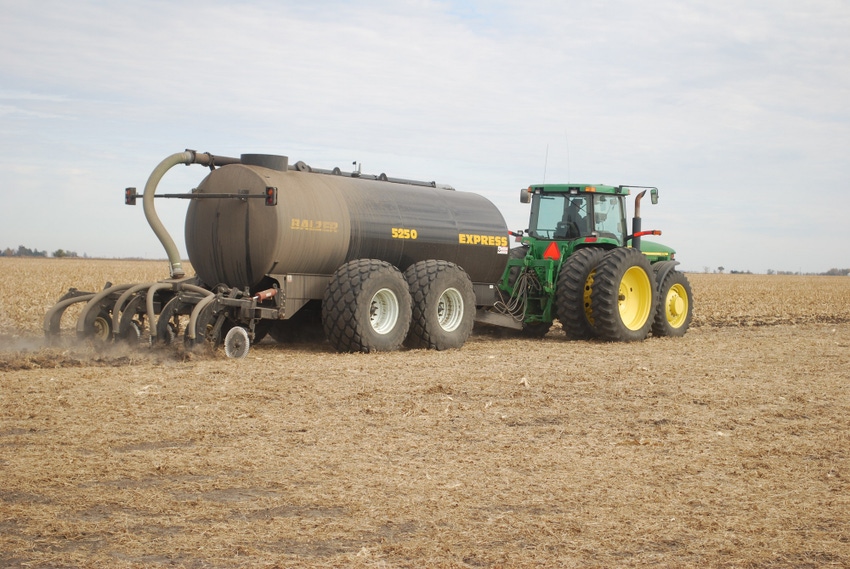Manure can help ease concerns around having enough phosphorus, potassium, sulfur and nitrogen.
November 16, 2021

The 2021 fall harvest is nearly complete. Row crop farmers are looking forward to the 2022 growing season as they contemplate spring planting intentions. Their decisions impact fertilizer and tillage activity, which they’ll complete yet this fall. Fertilizer prices are higher than a year ago – almost double in some cases. There are areas across the Midwest where it isn’t possible to book key fertilizer components for spring application yet. Some co-ops are even having issues getting potash to spread yet this fall. It can feel uncomfortable putting half of the fertilizer down this fall while being uncertain of the cost and availability for the spring. But manure may be your answer. Manure can help ease concerns around having enough phosphorus, potassium, sulfur and the majority of nitrogen you need.
Manure value
Pig farmers are blessed to have the natural hedge that manure provides against commercial fertilizer price volatility and availability. Row crop farmers have known for years that manure brings incredible value to their cropping operations. Agronomists are telling us that manure is offsetting roughly $125/acre of commercial fertilizer costs this fall – a figure based on prices locked in before harvest. Spot fertilizer prices have since escalated, further magnifying cost savings.
Manure value depends on the production cycle that generates the manure. Sow farms and nurseries will have less concentrated nutrient value than finishing barns will have. Even finishing sites will vary depending on feeder types, diet configuration and barn utilization levels. Many producers’ nutrient values have improved in 2021 compared to prior years. This saves on application costs as there is less water per pound of nutrients applied to the field. It also speaks to the effort farms are putting forth to improve efficiency in using water and other natural resources.
As a barn owner, it is interesting to look at the fertilizer value on a per space basis. Assuming 250 gallons of manure are generated per space in a typical wean-to-finish barn and that 4,000 gallons of manure are applied per acre, the $125/acre savings equates to just over $7.75 per space. This adds tremendous value to barn owners. If you are looking for a way to find a transfer value between a barn owner and a local neighbor, the University of Minnesota has a helpful manure value calculator.
Soybean impacts
High fertilizer costs will also impact planting intentions for the 2022 crop season. Soybeans need lower fertilizer inputs than corn. This shifts acres from corn to soybeans as farmers look to manage input costs and their total capital outlay. The value of soybean oil has shown impressive strength through much of 2021. Soybean meal prices have recently increased, as well.
Ports are having a difficult time getting ships unloaded and getting the containers out of the yards. As a result, foreign sourced lysine and other amino acids have become much more difficult to source. Nutritionists have started reformulating diets with higher soybean meal inclusion rates to compensate for constrained synthetic amino acid availability. The combined demand for meal and oil could have a mirroring effect on gross soybean prices as processors currently have the widest crushing margins in my data set that reaches back through 2015.
Corn markets
With all this excitement on the soybean side of the balance sheet, how will the corn market compete for attention? Ethanol margins continue to incentivize high grind levels as they pocket record margins. Will farmers plant enough corn to meet demand? Will enough fertilizer be available to achieve max yield potentials from today’s seed genetics?
We encourage producers to talk with their risk management advisors about opportunities to lock in a profit margin out through 2022. It is tempting to allow coverage levels to deteriorate this time of year as profit margins are not at their seasonal peak. With the threat of African swine fever (ASF) ever looming on the horizon, it is appropriate to assess your risk profile and your readiness for a domestic ASF case. Your risk management advisor can talk you through the complexities of managing inflationary feed cost exposure and using enhanced hog price protection tools. With the expansion of the LRP coverage limits coming in 2022, now is a great time to look at ways to protect profitable margins at a more cost-effective price point.
At the end of the day, costs may go up, but if you can manage to lock in profitable margins, 2022 has the potential to be a great year ahead.
About the Author(s)
You May Also Like





